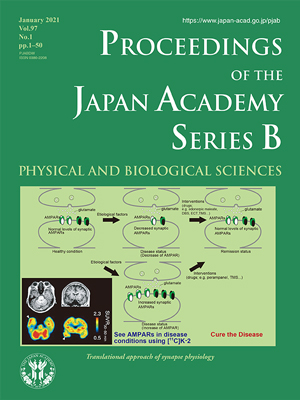About the Cover
Vol. 97 No. 1 (2021)
Neuropsychiatric disorders are a major cause of the degradation of quality of life. Slow progress in the development of diagnostics and therapeutics is due to limited evidence on the biological basis of these disorders in humans. Synapses are fundamental structural units of neurotransmission, and the malfunction of synapses is considered to underlie neuropsychiatric disorders. Thus, translational approaches based on synaptic physiology are imperative to break the current frustrating situation with these disorders. Excitatory glutamatergic synapses play central roles in neuronal functions. Glutamate α-amino-3-hydroxy-5-methyl-4-isoxazole propionic acid receptor (AMPAR) is a principal component of glutamatergic neurotransmission and is considered to be a promising translational target. Takahashi and colleagues (this issue, pp. 1-21) found that an experience such as learning drives AMPAR into synapses in various brain regions, which constitutes a crucial mechanism of experience-dependent neural plasticity. They focused their efforts on a translational approach to tackle neuropsychiatric disorders based on their findings with basic synapse physiology. They have recently identified a small compound, edonerpic maleate, which accelerates motor function recovery from brain damage by facilitating synaptic AMPAR delivery. This compound is currently being tested in a clinical trial to test the efficacy on patients with stroke. Furthermore, they developed the first technology to visualize and quantify AMPAR in living human brains using positron emission tomography (PET). Using their PET tracer for AMPAR, [11C]K-2, they are currently imaging patients with neuropsychiatric disorders such as schizophrenia, depression, autism, dementia, and epilepsy. They aim to characterize the biological bases of these disorders and to classify them according to the distribution of AMPAR, establishing a novel synaptic disease concept, “AMPA receptor disorders”. This approach may not only provide a brand-new diagnostic system but also accelerate the development of drugs directly or indirectly acting on AMPARs by targeting appropriate diseases. Moreover, it may be possible to select suitable patients for recruitment into clinical trials based on “AMPAR-phenotype” using [11C]K-2 as companion diagnostics. In fact, [11C]K-2 is being used in the current clinical trial of edonerpic maleate for the biological validation of functional recovery. This will ultimately enable choice of appropriate treatment options (e.g. AMPAR agonist, AMPAR antagonist, focal stimulation) for morbid conditions based on the distribution of AMPARs. This translational strategy also includes the creation and optimization of animal disease models based on the synaptic phenotype of patients, which will lead to the further elucidation of the mechanisms responsible for neuropsychiatric disorders, paving the way for the next round of translation into humans.
Shigetada Nakanishi
Member of the Japan Academy




